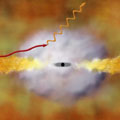CXC Home | Search | Help | Image Use Policy | Latest Images | Privacy | Accessibility | Glossary | Q&A
Q&A: Galaxies, Galaxy Clusters, AGN, and Quasars
Q:
With regard to the Quasar with the massive black hole, recently discovered 12.7 billion light years distant, if we assume the quasar to be immediately opposite the original site of the big bang from our viewing location, and the universe is assumed to be 13.7 billion years old, then we must be at least 11.7 billion light years distant from the site of the big bang (and that's taking the ridiculous stance that the quasar removed itself from the big bang locus at light speed for its first billion years! Any less velocity and we'd have to be even farther away from where the big bang occurred.)
For us to be able to reside at such a tremendous distance from where the big bang occurred, we'd need to travel at an average of 11.7 / 13.7 (or 85%) of the speed of light from the moment of the big bang, directly away from the direction of the observed quasar, for the entire 13.7 billion years of our universe's existence.
I don't think either of those scenarios is possible (the quasar traveling at light speed, or our galaxy's matter averaging 85% light speed or more, for all the universe's 13.7 years' existence.) This causes me to doubt (a) the big bang theory, (b) the age of the universe, or (c) my own reasoning. Can you help get me out of this paradox?
A:
The Big Bang theory holds that all of space and time came into existence in an instant. Space was created at the time of the Big Bang, and therefore you cannot point to a place in space and say that we've been expanding outwards from "there" for the last 13.7 billion years. Indeed we believe that if we were able to look outwards from a distant galaxy, the Universe would look the same as it does from Earth. And from that galaxy the visible Universe would extend 13.7 billion light years outwards, as it does for us.



